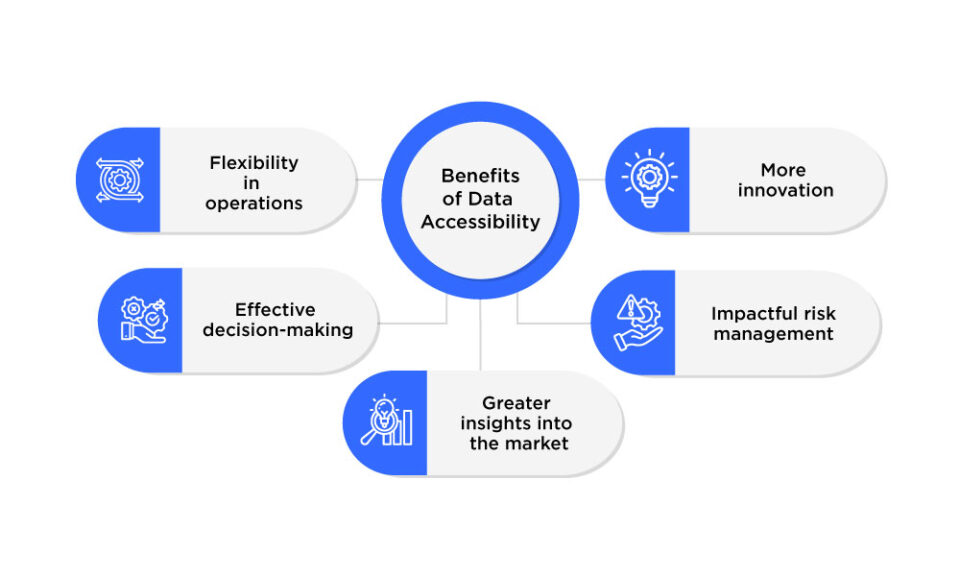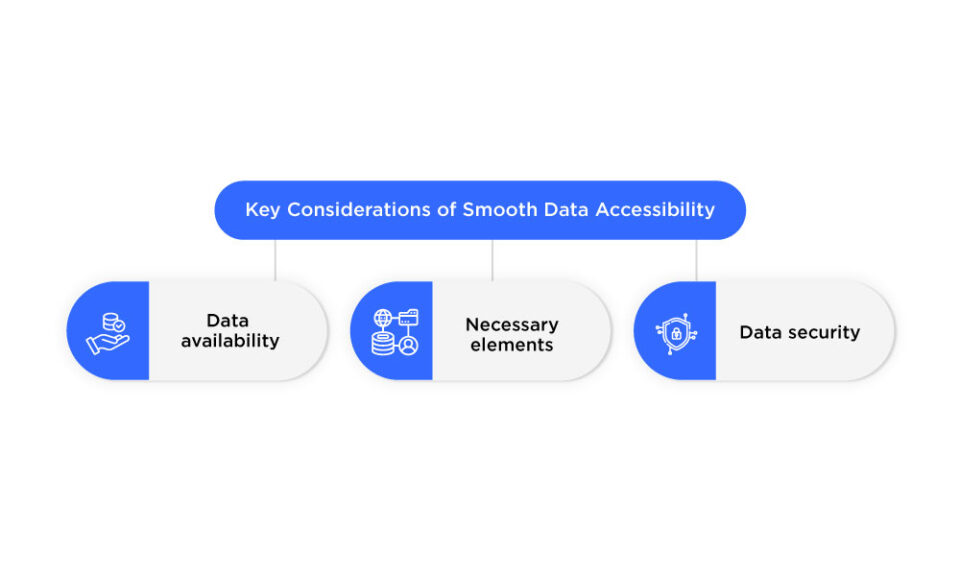Data is crucial to every business in today’s tech-driven world. With greater insights into the target audience and competitors, data empowers companies to stay ahead of the growth curve. In short, data is the fuel of the ever-evolving engine of the commercial setup, driving innovation and growth. Nevertheless, accessing relevant data has been a challenge for many business pioneers.
Among companies aiming to utilize data for progression, half fail to access appropriate datasets that are relevant. Data states that only 19.3% of global organizations are able to successfully integrate a data-driven culture. One of the key causes for this is ineffective data accessibility. As a result, marketers fail to achieve their business goals.
This article shall revolve around the chief components of data accessibility, including advantages, challenges, and processing, to understand its power in contemporary times. Let us first understand the basics of data accessibility.
What is Data Accessibility?
Data accessibility is the method of identifying, extracting, comprehending, and utilizing relevant data in a business. As the significance of data is beyond elaboration in today’s commercial arena, appropriately accessing it is also essential. Companies gather data using various sources and leverage it in many ways. However, it is essential to consider whether appropriate and relevant data is accessible to users or not.
Each department in an organization requires relevant data to operate and deliver fruitful outcomes. Without data, marketing and sales teams won’t be able to initiate their targeting and promotional strategies. In a way, a company will fail to identify the right audience, contributing to inefficient marketing activities.
To ensure smooth accessibility, companies implement several technologies, such as cloud computing and virtualization. Easy accessibility procedures assist companies in fast-forwarding digital transformation within the organization, enabling employees to easily retrieve and use required data. In this way, companies can achieve agility by making data easily available for their workforce.
There can be many causes of inefficient data accessibility, including software and hardware barriers, data unavailability, and security concerns. Nevertheless, addressing all these concerns is crucial for companies to ensure convenient accessibility of data.
Benefits of Data Accessibility:

Smooth accessibility of data can be beneficial in multiple ways in an organization. It bridges the gap between employees and valuable data that they need to execute day-to-day tasks.
Flexibility in operations:
Data availability has been a big challenge for many companies that had a direct impact on the operations. Convenient access to data enables employees to boost the speed of their tasks, bringing efficiency. Agility in operations also allows organizations to attain their business goals easily.
Effective decision-making:
Data availability encourages employees to stay informed about their industry and target audience. This helps people in making solid predictions and forecasts unveiling the most accurate possibilities in their industry. As a result, they can make solid decisions that drive success.
Greater insights into the market:
The entire workforce of a business should be aware of its target market and audience. It contributes to the effective execution of determined strategies. Data accessibility enhances the knowledge of employees on different dimensions of their employees. In a way, the workforce can gain in-depth insights into their market segments.
Impactful risk management:
Data availability helps in maintaining transparency between employees and their employers. In this process, data is stored in secured servers that are generally isolated from people without authentication. This process assists in impactful risk management in case of cyber-attacks. Therefore, even if a company encounters certain challenges, it becomes easy to overcome those while implementing data accessibility strategies.
More innovation:
Adopting data accessibility strategies supports businesses in aiming for and achieving digital transformation. In today’s tech-driven commercial realm, it is essential for all companies to integrate innovation into their business model. Making data accessible across digital servers is the initial step of innovation, which also contributes to gaining a competitive edge.
Challenges to Accessing Relevant Data:
Though data is an asset of all businesses, several barriers arise when making it accessible. Let us discuss a few-
Data quality:
The quality of data can create major difficulties while making it available for a company's entire workforce. If the data is irrelevant and does not provide value, there is no point in accessing and utilizing it. Therefore, companies must consider data quality to boost accessibility strategies.
Data silos:
Data silos are the method of gathering and storing datasets in isolation, where they are handled separately. The data is not unified, rather fragmented and decentralized. While integrating strategies for the accessibility of data, analyzing and utilizing these separated datasets becomes challenging.
Technical knowledge:
Accessibility of data uses elements of cloud computing and virtual servers, operating which, without appropriate knowledge can be difficult for employees. For this purpose, companies need to arrange knowledge-sharing sessions, which can be time consuming. Such factors create difficulties while adopting data accessibility.
Cost:
Incorporating data accessibility technologies is an extra investment that companies have to make. Most often, small and medium-sized organizations find it difficult to make such investments due to high costs.
Key Considerations of Smooth Data Accessibility:

While aiming to make necessary data easily available for employees, companies need to look after a few factors. These factors make data accessibility strategies more effective, bringing more flexibility.
Data availability: To offer better accessibility, companies initially have to gather and analyze valuable data. Data gathered from various sources includes extra information that might not seem relevant to the company. Therefore, thorough data analysis is important to extract the most valuable insights and make them available to employees.
Necessary elements: While offering smooth data accessibility, companies must ensure that all employees have updated software, systems, and tools. Businesses make data accessible through cloud and virtual servers. Therefore, convenient data access is impossible if everyone within the organization does not use compatible tools and systems.
Data security: Data security is key to providing smooth data access to multiple people. Having proper security measures ensures that available data is protected from possible data breaches. Moreover, companies also have to think about appropriate accessibility distribution to the employees. For example, an executive-level employee should not access confidential finance-related data of the other workers which is supposed to be utilized by the finance department. Hence, businesses also have to evaluate who is accessing which data while securing it.
Final Words!
Businesses worldwide are turning toward a data-driven approach lately. However, many enterprises fail to make useful data available for their employees due to several hurdles. The common factors for such failure are the availability of relevant data, high costs, and so on. As a result, impactful businesses fall behind in gaining a competitive edge and progressing in the industry. Data accessibility can be a top-notch tactic in this regard.
Making valuable data available for the workforce can be highly beneficial for companies, bringing agility to operations. Smooth accessibility also contributes to sustaining digital transformation, effective risk management, and firm decision-making. Therefore, companies aiming to implement a data-driven business model should incorporate data accessibility technologies as soon as possible. Ensuring compatible tools and data security are the chief considerations for making data accessible for employees.
Explore more informative and insightful content with us at WisdomPlexus! We cover a wide range of topics, including technology, marketing trends, and data security.
Recommended For You:
From Data to Decisions: Role of Prescriptive Analytics in Business Success




